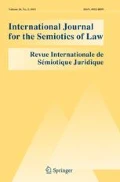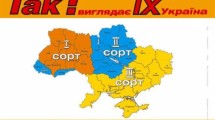Abstract
A crucial element of sovereignty politics concerns the role that juridical techniques play in recursively creating images of the sovereign. This paper aims to render that dimension explicit by focusing on examples of crime-focused law and colonial rule at the Cape of Good Hope circa 1795. It attempts to show how this law helped to define a colonial sovereign via such idioms as proclamations, inquisitorial criminal procedures, and case narratives framing the atrocity and appropriate punishment for crimes. Referring to primary texts of the time, the paper explores how procedures and narratives of Cape law were also deeply involved in fashioning specific images of the sovereign in whose name it claimed to operate.
Similar content being viewed by others
Notes
See also Pavlich [19].
This turbulent transition was followed some 8 years later with the Cape’s return to the Batavian Republic in 1803 and a second British occupation in 1806 [1].
See Foucault [10, p. 51].
In particular, these have been selected from fifty ‘criminal’ cases between 1792 and 1803, all of which may be found in the CJ series at the Western Cape Archives and Records Services (WCARS).
WCARS CJ 797 #279.
WCARS CJ794 #357.
WCARS, CJ798 #169.
WCARS, CJ798 #271.
WCARS CJ 798 #131.
WCARS, CJ. 798# 41.
WCARS, CJ. 798# 85.
WCARS, CJ. 797 #225.
WCARS, CJ.799 #171.
WCARS, CJ. 796 #339. (translation by Jean Blakenberg).
For example in the case of an unintentional death of infant, a man was flogged, put in chains and ordered to 15 years at public works. (WCARS CJ 799 #304). As well, Cesar of Boegies whose ‘violent resistance’ was deemed unintentional in the course of a fight—he was flogged and given 3 years in chains. (WCARS CJ 799 #356).
References
Anderson, M.R.D. 2008. Blue Berg: Britain takes the Cape. Cape Town: Anderson.
Boucher, M., and N. Penn. 1992. Britain at the Cape, 1795 to 1803. Johannesburg: Brenthurst Library.
Comaroff, J. 1998. Reflections on the Colonial state in South Africa and elsewhere: Fragments, factions, facts and fictions. Social Identities 4(3): 321–361.
Dooling, W. 1992. Law and community in a slave society: Stellenbosch District, South Africa, c. 1760–1820. Cape Town: Centre for African Studies, University of Cape Town.
Fine, H. 1991. The administration of criminal justice at the Cape of Good Hope 1795–1828 (Vol. PhD). Cape Town: University of Cape Town.
Foucault, M. 1977. Discipline and punish: The birth of the prison. London: Penguin Books.
Foucault, M. 1980. Power/knowledge: Selected interviews and other writings, 1972–1977. New York: Vintage.
Foucault, M. 2000. Power. New York: New Press.
Foucault, M. 2003. Society must be defended: Lectures at the College de France, 1975–76. New York: Picador.
Foucault, M. 2008. The birth of biopolitics: Lectures at the College de France, 1978–79. New York: Palgrave Macmillan.
Giliomee, H., and B. Mbenga (eds.). 2007. New history of South Africa. Cape Town: Tafelberg Publishers.
Giliomee, H. 1975. Die Kaap tydens die eerste Britse bewind, 1795–1803. Cape Town: Tafelberg Publishers.
Golder, B., and P. Fitzpatrick. 2009. Foucault’s Law. London: Routledge.
Loos, J. 2004. Echoes of slavery: Voices from South Africa’s past. Cape Town: David Phillip Publishers.
Magubane, Z. 2004. Bringing the empire home: Race, class, and gender in Britain and colonial South Africa. Chicago: University of Chicago Press.
McCarthy, T. 2009. Race, empire, and the idea of human development. New York: Cambridge University Press.
Pavlich, G. 2010. Legal judgment and Cape colonial law. Law, Culture and the Humanities 7(2): 1–12.
Pavlich, G. 2011. Law and society redefined. Don Mills: Oxford University Press.
Pavlich, G. 2011. Sustaining sovereignty through law at the Cape Colony, 1795–1803. Journal of Forensic Psychology Practice 11(2–3): 184–203.
Ross, R. 1993. Beyond the pale: Essays on the history of colonial South Africa. Hanover: University Press of New England.
Ross, R. 2008. A concise history of South Africa. New York: Cambridge University Press.
Stoler, A.L. 2009. Along the archival grain: Epistemic anxieties and colonial common sense. Princeton, NJ: Princeton University Press.
Theal, G.M. 1898. Records of the Cape Colony. London: W. Clowes and Sons.
Wessels, J.W. 2005. History of the Roman Dutch law. New Jersey: The Lawbook Exchange.
Worden, N., and G. Groenewald (eds.). 2005. Trials of slavery. Cape Town: Van Riebeck Society.
Acknowledgment
The author acknowledges with gratitude a Social Sciences and Humanities Research Council of Canada standard research grant that supported this work, and Patrick McLane for his excellent research assistance. I gratefully acknowledge the helpful assistance of the staff at WCARS, and Ms. Jean Blackenberg for translation assistance.
Author information
Authors and Affiliations
Corresponding author
Rights and permissions
About this article
Cite this article
Pavlich, G. Cape Legal Idioms and the Colonial Sovereign. Int J Semiot Law 26, 39–54 (2013). https://doi.org/10.1007/s11196-012-9261-1
Published:
Issue Date:
DOI: https://doi.org/10.1007/s11196-012-9261-1




